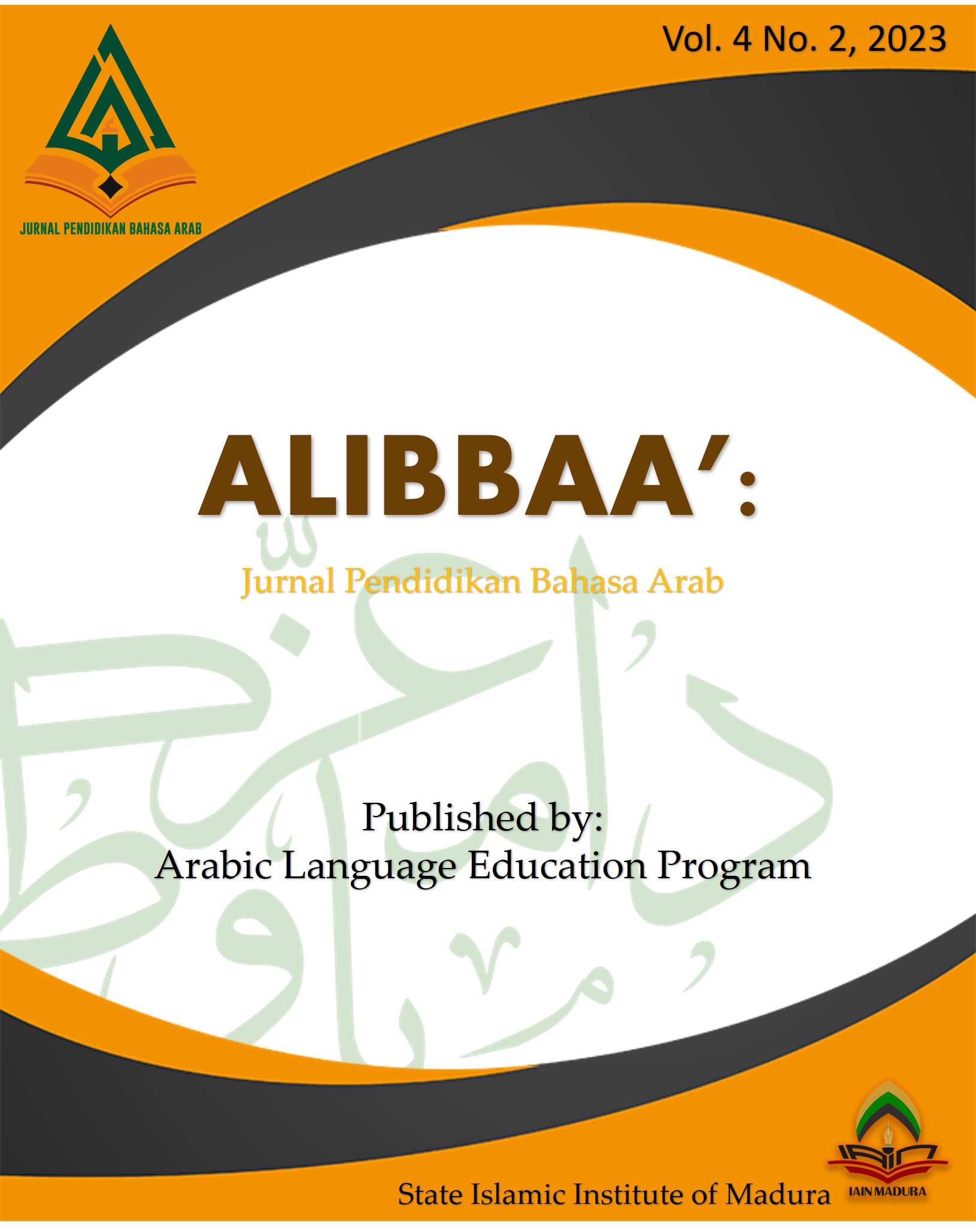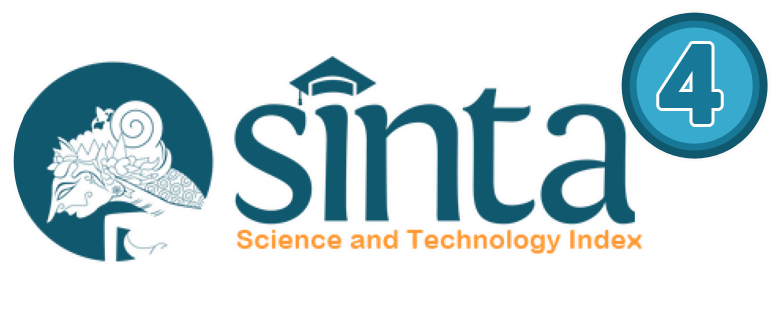Penggunaan Istilah Psikologi Arab dalam Mu'jam Mustakhalahats 'Ilm Nafsi untuk Pengayaan Konsep Psikologi Indonesia
 Abstract views: 458
,
Abstract views: 458
,
 pdf downloads: 392
pdf downloads: 392
Abstract
The purpose of this study is to provide an overview of the use of Arabic psychological terms originating from Mu'jam mustakhalahats 'ilm nafsi for the development of Indonesian psychological terms through the translation process. In this study, the authors used a descriptive qualitative method by collecting data in the form of psychological vocabulary, recording and collecting psychological vocabulary, analyzing psychological vocabulary, and then finally providing explanations and analysis using Abdul Chaer's morphological theory. The results of the study show that the use of Arabic psychological terms in Mu'jam Mustakhalahats 'Ilm Nafsi has relevance in the context of the development of psychological concepts in Indonesia. By understanding these terms, psychologists in Indonesia can enrich aspects of theoretical and practical understanding, as well as develop an inclusive and comprehensive approach in understanding and explaining psychological, social and cultural phenomena in Indonesian society.
Downloads
References
Al-Zubi, Dalal, Ahmad El-Sharif, and Karem H. Alzoubi. “Changes in the Attitudes of Professors and Students of Medicine towards Arabicizing Medical Terms in the Faculties of Medicine: A Study from Jordan.” Heliyon 8, no. 12 (2022): e12022. https://doi.org/10.1016/j.heliyon.2022.e12022.
Alhawatmeh, Hossam, Sami Alshammari, and Jehad A. Rababah. “Effects of Mindfulness Meditation on Trait Mindfulness, Perceived Stress, Emotion Regulation, and Quality of Life in Hemodialysis Patients: A Randomized Controlled Trial.” International Journal of Nursing Sciences 9, no. 2 (2022): 139–46. https://doi.org/10.1016/j.ijnss.2022.03.004.
Bordes, Joeri, Lucas Miranda, Bertram Müller-Myhsok, and Mathias V. Schmidt. “Advancing Social Behavioral Neuroscience by Integrating Ethology and Comparative Psychology Methods through Machine Learning.” Neuroscience and Biobehavioral Reviews 151, no. January (2023): 105243. https://doi.org/10.1016/j.neubiorev.2023.105243.
Chaer, Abdul. Morfologi Indonesia. Jakarta: Rineka Cipta, 2008.
Chairul, Syifa Fauzia, Darsita Suparno, Santje Iroth, and Donal Matheor Rattu. “Konflik Internal Tokoh Utama Dalam Mimpi Kecil Tita Karya Desi Puspitasari.” Dialektika 8, no. April (2021): 85–106. https://doi.org/10.15408/dialektika.v8i1.6188.
Evans, R C. “Neurobiology of Disease Dendritic Involvement in Inhibition and Disinhibition of Vulnerable Dopaminergic Neurons in Healthy and Pathological Conditions.” Neurobiology of Disease 172, no. July (2022): 105815. https://doi.org/10.1016/j.nbd.2022.105815.
Fitri, Helma. “Urgensi Psikologi Pendidikan Islmai Dalam Pengajaran.” Ihya Al Arabiyah: Jurnal Pendidikan Bahasa Dan Sastra Arab 6, no. 1 (2020): 140–50. https://doi.org/DOI: http://dx.doi.org/10.30821/ihya.v6i1.7972.
Gideon, Osei, Abass Adamu, and Opoku Daniel. “Heliyon Relation between Students ’ Personality Traits and Their Preferred Teaching Methods : Students at the University of Ghana and the Huzhou Normal University.” Heliyon 9, no. 1 (2023): e13011. https://doi.org/10.1016/j.heliyon.2023.e13011.
Irfani, Ranu Nada. “Formulasi Kajian Psikologis Tentang Teori-Teori Belajar Dalam Al-Quran Dan Hadits.” Ta Dib : Jurnal Pendidikan Islam 6, no. 1 (2017): 212–23. https://doi.org/10.29313/tjpi.v6i1.2319.
Jones, Peter E, and Catherine Read. “Mythbusters United ? A Dialogue over Harris ’ s Integrationist Linguistics and Gibson ’ s Ecological Psychology.” Language & Communication 97 (2023): 101536. https://doi.org/10.1016/j.langsci.2023.101536.
Kitano, Naomi, Tetsuya Shiroyama, Kohta Suzuki, Takashi Yamano, and Michi Tomiyama. “Association of Household Smoking Status in Childhood with Young Adults ’ Educational Attainment and Smoking Status : Results from a Series of Population-Based Cross-Sectional Surveys in Japan.” Preventive Medicine Reports 18, no. March 2019 (2020): 101066. https://doi.org/10.1016/j.pmedr.2020.101066.
Moyal, Natali, Liel Stelmach-Lask, Gideon Emanuel Anholt, and Avishai Henik. “Choosing an Emotion Regulation Strategy - The Importance of Emotional Category.” Journal of Affective Disorders Reports 12, no. December 2021 (2023): 100498. https://doi.org/10.1016/j.jadr.2023.100498.
Nasution, Sahkholid. Pengantar Linguistik Bahasa Arab. Medan: CV Lisan Arabi, 2017.
Niswah, Isniyatun, M Z Universitas, Hasyim Asy’ari, and Tebuireng Jombang. “Pola Derivasi Dalam Bahasa Arab.” Al-Lahjah 1, no. 2 (2018): 31–40. https://ejournal.unwaha.ac.id/index.php/lahjah/article/view/333.
Şafak-Ayvazoğlu, Ayşe, Filiz Kunuroglu, and Kutlay Yağmur. “Psychological and Socio-Cultural Adaptation of Syrian Refugees in Turkey.” International Journal of Intercultural Relations 80, no. February 2020 (2021): 99–111. https://doi.org/10.1016/j.ijintrel.2020.11.003.
Sudaryanto. Metode Linguistik: Ke Arah Memahami Metode Linguistik. Yoyakarta: Gadjah Mada University Press, 2015.
Sugiyono. Metode Penelitian Kualitatif. Bandung: Alfabeta, 2010.
Tarmizi. “Konsep Manusia Dalam Psikologi Islam.” AL-Irssyad 7, no. 2 (2017): 28–48. https://doi.org/http://dx.doi.org/10.30829/al-irsyad.v7i2.6700.
Toleon, C, A Deborde, S Ahmad, and S Vanwalleghem. “Contextual Influence of the COVID-19 Pandemic on Pregnant Women’s Emotional Regulation Abilities.” L’Encephale, no. xxxx (2022). https://doi.org/10.1016/j.encep.2022.05.010.
Xiao, Jie, Jianfeng Zhao, Zhiwen Luo, Fang Liu, and David Greenwood. “Health and Place The Impact of Built Environment on Mental Health : A COVID-19 Lockdown Perspective.” Health and Place 77, no. July (2022): 102889. https://doi.org/10.1016/j.healthplace.2022.102889.
Authors who publish with this journal agree to the following terms:
a. Authors retain copyright and grant the journal right of first publication with the work simultaneously licensed under a Creative Commons Attribution License that allows others to share the work with an acknowledgement of the work's authorship and initial publication in this journal.
b. Authors are able to enter into separate, additional contractual arrangements for the non-exclusive distribution of the journal's published version of the work (e.g., post it to an institutional repository or publish it in a book), with an acknowledgement of its initial publication in this journal.
c. Authors are permitted and encouraged to post their work online (e.g., in institutional repositories or on their website) prior to and during the submission process, as it can lead to productive exchanges, as well as earlier and greater citation of published work (See The Effect of Open Access).
Alibbaa': Jurnal Pendidikan Bahasa Arab have CC-BY-SA or an equivalent license as the optimal license for the publication, distribution, use, and reuse of scholarly work.
In developing strategy and setting priorities, Alibbaa': Jurnal Pendidikan Bahasa Arab recognize that free access is better than priced access, libre access is better than free access, and libre under CC-BY-SA or the equivalent is better than libre under more restrictive open licenses. We should achieve what we can when we can. We should not delay achieving free in order to achieve libre, and we should not stop with free when we can achieve libre.

Alibbaa': Jurnal Pendidikan Bahasa Arab is licensed under a Creative Commons Attribution 4.0 International License
You are free to:
- Share — copy and redistribute the material in any medium or format
- Adapt — remix, transform, and build upon the material for any purpose, even commercially.
- The licensor cannot revoke these freedoms as long as you follow the license terms.











